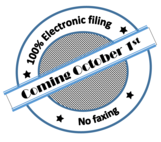
The countdown is on —
only five months remain until October 1, 2017. What happens then?
Beginning
October 1, the Office of Vital Records (OVR) will
direct all medical certifiers and their designated
staff to enter cause of death information directly
into Minnesota Registration & Certification (MR&C). As part of the Paper Cut Project, OVR has been working
to eliminate paper and faxes from the death registration process. By maximizing
the functions of MR&C, death registration and death records will
be more timely, accurate, and complete. Electronic death registration also
assures that the cause of death provided for authorizations for cremation as
final disposition are consistent with the cause of death recorded on legal
death records and death certificates.
Electronic death registration isn’t new. Minnesota was an early
adopter initiating electronic death registration two decades ago. Funeral staff
register all deaths directly into the statewide vital records system. After
launching MR&C
in 2011, OVR focused
on registering the cause of death electronically. Initially OVR pushed hard to
recruit physicians to become online users
and OVR allowed physicians to designate staff to input the cause of death data
that the physician provided into MR&C on the physician’s behalf.
Our efforts along with funeral directors
encouraging physicians to “get online” were productive but leveled off with about 75 percent of
Minnesota death records completely filed electronically in MR&C.
For a number of reasons, paper requests to
authorize cremation and paper worksheets to provide the cause of death
continue to circulate, mostly by faxes, among funeral staff, clinics,
physicians, medical examiners and coroners. Sometimes this results in
physicians providing the cause of death two and three times if the physician
was an MR&C user for the same decedent. Ultimately, paper worksheets
are faxed to OVR to enter death data into MR&C and finalize the
record.
In
2016, the Ramsey and Hennepin County medical examiner offices stopped approving
paper cremation requests and went to approving cremation requests
electronically through MR&C. This action spurred large numbers of
physicians to become MR&C users in 2016. OVR is
targeting health care organizations and has worked directly with many clinics
and hospitals.
Cutting the paper out of the death registration process has already
yielded these results:
- Physicians
or designates enter causes of death into MR&C about 95% of the
time—up from 67% in 2012.
- The
number of death records filed legally and medically within 5 days of death has increased
from 46% in 2016, to 78% during the first quarter of 2017.
Additional
benefits:
- Physician
(or designate) provides cause of death
(COD) information once—in MR&C
- MR&C
populates cremation authorization requests
with data directly from the death record
- COD
on death record and
cremation authorization are consistent and the
medical certifier is the same
- Cremations are approved
“on line”
- Deciphering
errors reduced (handwriting, fax illegibility)
- Timeliness,
data accuracy, quality and security improved
- Decedent’s
family gets accurate death certificates more quickly
- Positions
all of us for interoperability among electronic systems
During these countdown months, funeral establishments
and physicians need to maximize their use of the
MR&C:
- STOP faxing cause of death worksheets
- STOP faxing cremation request
forms
- Encourage physician colleagues to get an MR&C user account
- Reach out to OVR for help in recruiting, training, and
onboarding new MR&C users
Contact the OVR Help Desk at
651-201-5970![Call: 651-201-5970]() or health.MRCAdmin@state.mn.us
to become an MR&C user, talk to someone about MR&C training, or to
obtain more information about the countdown. or health.MRCAdmin@state.mn.us
to become an MR&C user, talk to someone about MR&C training, or to
obtain more information about the countdown.
|
Moving Information: vital records
data exchanges
Today’s world demands data to inform decisions, prove
hypotheses, measure changes, performance and improvement. With our partners,
the Office of Vital Records (OVR) collects, stores, and shares information
about Minnesota’s vital events. Our work and responsibility is at the
intersection of data, technology, and time. More and more agencies, programs,
and individuals need our data to be complete, accurate, and timely. And more of
these audiences expect and demand our information to be accessible and
available, increasingly in real-time.
Vital records offices across the country are re-engineering
and building capacity. Minnesota is no exception. Although OVR is still a long way
from interoperability, where systems exchange data easily and routinely, we are
gearing up and positioning processes for a future state that supports more
efficient and effective data exchange. We have systems that help us collect, store, and share data
securely and efficiently today. These include systems and applications used
within Minnesota and across jurisdictions.
Minnesota Registration and Certification
(MR&C)
MR&C is OVR’s electronic vital records system. It is a
single web-based application that provides for:
- electronic registration of births, deaths, fetal
deaths
- secure storage of data in a statewide database
- issuance of certified and non-certified
documents from vital records
- sharing data through direct system access, file
downloads, and reports.
MR&C has more than 8,000 users statewide. It was created
specifically for Minnesota and introduced in 2011. System maintenance and
upgrades are handled by the State of
Minnesota’s central IT organization (MNIT).
State and Territorial Exchange of Vital
Events (STEVE)
STEVE is a system owned and operated by the National
Association of Public Health Statistics and Information Systems (NAPHSIS) that
allows OVR and other vital records jurisdictions to:
- Maintain control of their data and its release.
- Send statistical data to the CDC’s National
Center for Health Statistics (NCHS) for inclusion in the National Vital
Statistics System and receive ICD-10 coded death data back from NCHS.
- Send and receive vital events about residents in
other jurisdictions.
STEVE allows OVR to receive data about Minnesota residents who give birth or die
outside our state and to send data about non-residents who give birth or die in
Minnesota to their states. This helps us track not only what happens within our
borders but what happens to our residents when they are away from Minnesota. For
example, because of STEVE, we know how many people died IN Minnesota and how
many MINNESOTANS died.
- Reduce fraud and identity theft. Not everyone
dies in the state where they were born. By using STEVE, OVR and other
jurisdictions receive death information so that we can flag birth records and
mark birth certificates as 'deceased’.
- Provide data to authorized data partners for authorized public health and administrative purposes. STEVE works like a
mailbox where OVR can send data to external and internal Minnesota Department
of Health (MDH) programs such as birth defects.
Electronic Verification of Vital Events
(EVVE)
The EVVE system, owned and operated by
NAPHSIS, allows immediate confirmation of the legitimacy of a US birth
certificate presented to a government office anywhere in the
nation. EVVE helps government agencies reach across jurisdictions to accomplish
their work. It is a secure tool like STEVE that allows jurisdictions to control the release of data, and it is an efficient and effective business
solution that generates fee revenue for OVR. Using EVVE, authorized users can send
an electronic query to OVR and other participating vital records jurisdictions
to securely:
- Help the U.S. Department of State verify the validity and legitimacy of a paper birth
certificate submitted as
part of a U.S. Passport application.
- Request
an electronic birth certification instead of the paper birth certificate.
- Provide
an immediate electronic response to the user that either verifies or denies the
match with the official records.
- Flag
responses in which the person matched is actually deceased, an important step
that prevents fraud.
Electronic Verification of
Vital Events—Fact of Death (EVVE FOD)
EVVE FOD is a new system operated by NAPHSIS that permits government
and non-government customers to quickly, reliably, and securely discover if a death record exists. Authorized users send single or batch file inquiries through EVVE FOD to be matched against death records from state and
jurisdiction vital record databases nationwide. An electronic response from the
state or jurisdiction either returns the date and place of death or denies a
match within a matter of seconds. Fees are based on volume. EVVE FOD went live in March 2017 with data available from 37 of the 57
jurisdictions including Minnesota. Read more in the NAPHSIS Releases New Fact of Death Query Service: Revolutionizes Availability of Death Record Data press release.
The future holds many possibilities for vital records. Technology as
well as the expectations and demands of our partners and customers will shape
how we collect and manage our data. Interoperability is on the horizon for many
programs including vital records. MDH has embarked on a new project to move the
agency and its programs forward. Our vision: better public health
through standardized electronic data exchange with our partners. See the MDH Minnesota e-Health
webpage for more information about e-health and the initiative to adopt effective use of Electronic
Health Record (EHR) systems and other health information technology (HIT).
Stay “IN THE KNOW” with Vital Records News
 The Office of Vital Records (OVR) uses Vital Records News to inform customers and stakeholders of Minnesota’s vital records program and the Minnesota Registration & Certification (MR&C) system. OVR wants you to be up-to-date and “in the know”.
Each month, the OVR newsletter team sits down to decide on the content of Vital Records News. We would love to hear your ideas and suggestions for items you would like to see in future editions. Please send your recommendations to health.MRCAdmin@state.mn.us. We look forward to including your ideas in upcoming issues.
We are also looking for a few champions to help spread the word about Vital Records News. Share the newsletter with your colleagues to help keep them “in the know”. Your colleagues can self-subscribe using the link at the bottom of this Minnesota Department of Health Office of Vital Records page.
Let us know that you read Vital Records News! Send an email to health.MRCAdmin@state.mn.us on or before Wednesday, May 10 at 4 p.m. with the words “I read Vital Records News” in the subject line. One individual selected from of the pool of responses will get a prize and recognition in the June issue of Vital Record News.
Good luck and thank you for your readership. We are thankful for YOU and all you do.
|
|